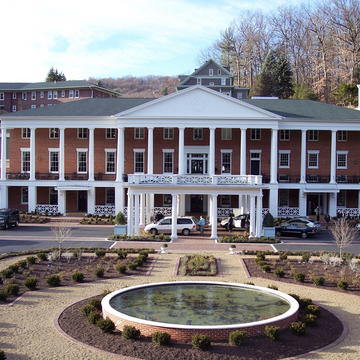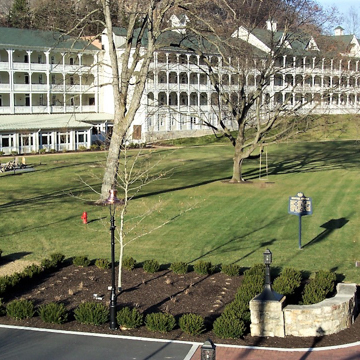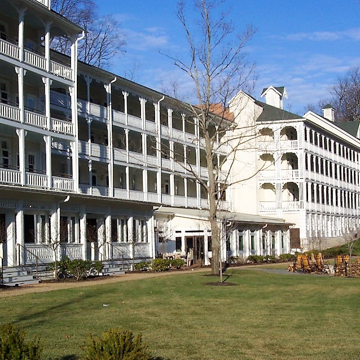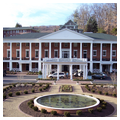Founded in 1802 by Bedford native Dr. John Anderson, the Bedford Springs Hotel was once as famous as the mineral spas at Saratoga Springs or Greenbriar. Today, its sprawling complex of buildings has been restored to compete with spas like Nemacolin Woodlands in Fayette County ( FA30) or the Homestead in West Virginia. It is remarkable that the nineteenth-century resort continued to function until the late 1980s. When first built, guests arrived by carriage and, after 1873, by train, then by carriage from Bedford one-half mile to the north or from Cumberland thirty miles to the south, and later by car from the Pennsylvania Turnpike four miles to the north. The hotel comprises six contiguous buildings. The central anchor building, designed between 1829 and 1842 by Solomon Filler, is a Greek Revival, hipped-roof, three-story brick building housing the lobby and main dining rooms. To the north, four more hipped-roof buildings dating between 1802 and 1890 share common galleries with wooden railings in a variety of harmonizing styles. Although the buildings differ in height from three to four stories, there is a unity of design, materials, and scale. To the south is a two-story, gable-roofed building of 1903 that houses the indoor pool beneath a vaulted ceiling, and has French doors opening to a colonnade, solarium, and hydrotherapy rooms.
An eighteen-hole golf course incorporating features designed by Spencer Oldham (1895),
President James Buchanan used the springs as his summer White House, and the Supreme Court met here during summer sessions between 1857 and 1861. Ten American presidents have visited Bedford Springs. In addition, the resort was used as the Naval Radio Training School during World War II, and Japanese diplomats were detained here when they were captured in Berlin near the end of the war.
Before the resort was built, the surrounding 2,800 acres were known for seven mineral springs and the stone Nawgel or Nauglě gristmill (1797) that stands northeast of the hotel. The stone mill took its power from Shober's Run. A log house of the same period lies to the southwest.




















